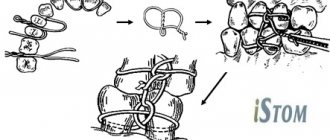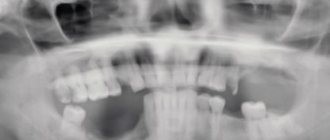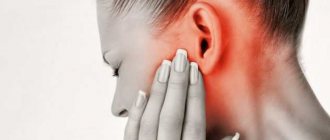Periostitis of the jaw (flux) refers to dental diseases. The localization of the source of inflammation occurs in the periosteum. A subperiosteal abscess is formed, and the peri-maxillary soft tissues swell. A person experiences painful sensations radiating to the temporal region, ear, eye; his health worsens: weakness, sleep disturbances, fever, and headaches occur.
Periostitis, aka gumboil
The disease is diagnosed by inspection and palpation; an x-ray is required for confirmation. The doctor opens and drains the subperiosteal abscess and removes the tooth that is the source of infection. After this, the patient must undergo a course of physiotherapy and antibiotic treatment. It is also necessary to rinse your mouth regularly.
What kind of diagnosis is this? According to the international classification ICD-10, accepted throughout the world, periostitis of the lower jaw is assigned code K10.2.
Reasons for the development of periostitis
The causes of periostitis of the jaw are usually infection or injury. According to statistics, in practice this disease is observed in 5.4% of patients with inflammation in the face and jaw. Moreover, 95% of patients have an acute form, 5% have a chronic form. Localization of periostitis is observed one and a half to two times more often in the lower jaw. The clinical picture, both local and general, is peculiar. If the treatment process is started on time, it will end successfully, otherwise the disease progresses, which carries a high probability of severe purulent complications.
Why does this disease occur? There are several reasons. And the main one is complicated caries, in which pathogenic microflora penetrate through microchannels into the tooth cavity and then spread to the tissue surrounding the root.
Often periostitis is caused by chronic apical periodontitis. Diseased microorganisms move further and further through the channels over time. If the disease is not treated, the soft tissues are first affected, then the periosteum.
Staphylococcus always lives in the oral cavity. If the immune system is weakened, the population begins to grow and the periosteum becomes inflamed.
The hematogenous and lymphogenous form is usually caused by ENT diseases, ARVI, and infectious diseases such as measles and scarlet fever. Traumatic periostitis may occur after tooth extraction or trauma, surgical intervention, jaw fractures, infected wounds on the face, etc.
In many patients, periostitis is caused by previous hypothermia or overheating, as well as emotional or physical overload.
There are other reasons, less common: tuberculosis and other diseases that are fraught with complications spreading to the jaw periosteum.
The etiology and pathogenesis of periostitis in modern dentistry has been studied quite well. Treatment usually does not cause problems.
Differential diagnosis of acute periodontitis, periostitis, odontogenic osteomyelitis of the jaws.
Acute periostitis, in which inflammatory phenomena develop in the periosteum and soft tissues, differs from acute or aggravated chronic periodontitis in the localization of the inflammatory focus and the severity of the inflammatory reaction. In periodontitis, inflammation is localized in the projection of the apex of the root of the causative tooth; in periostitis, inflammation spreads under the periosteum. With periodontitis in the area of the periosteum and soft tissues on the side of the vestibule of the oral cavity, a small reactive collateral edema can be detected, and with periostitis, an inflamed infiltrate is localized in this area and a subperiosteal abscess is formed, which is determined by the presence of severe pain and the symptom of fluctuation. Spontaneous pain in the tooth, as well as pain when biting and percussion, is significantly reduced or disappears, unlike periodontitis. Mild or moderate symptoms of intoxication are noted, which is confirmed by temperature reaction and clinical blood test data. In acute osteomyelitis , unlike periostitis, the inflamed infiltrate is localized on both sides of the alveolar process, covering it in a muff-like manner (bilateral periostitis). With osteomyelitis, the mobility of several teeth located in the affected area is determined, and Vincent's symptom develops. The pain of the causative tooth is less than that of neighboring teeth.
Acute osteomyelitis is accompanied by more severe general intoxication of the body, severe hyperthermia, chills, impaired autonomic functions and pain.
85. Ankylosis of the ANS. LF contracture
Reduction of the jaws, characterized by significant limitation or complete absence of movements in the TMJ, associated with persistent fibrous or bony fusion within the joint with the glenoid cavity of the temporal bone.
Damage occurs to the soft tissue of the joint surface, and the surface cartilage becomes cloudy. The meniscus splits into fibers. The joint capsule shrinks. The synovial membrane is degenerating, degenerating. The cartilage gradually disappears. Both joints on top. turn into dense scar tissue (fibrosis, ankylosis), then ossify (bone ankylosis). The amplitude of movements of the LF decreases.
One-sided and two-sided
Complete (bone) and partial (fibrous).
Diagnosis: X-ray for fibrous: uneven joint width. Cracks, with bone - shortening of the branch and condyles of the process of the LF. The joint gap is not determined. The angle of the jaw is deformed.
Treatment: physiotherapy: (phonophoresis, ultrasound), dissolving medications (iodide solution, lidase, hyaluronidase)
Surgical treatment: creation of a false joint, restoration of the size, shape of the jaw and bite.
Contracture is the restriction of movements of the lower jaw or the reduction of the jaws to complete immobility.
1. Inflammatory (trismus) – with direct and reflex irritation of structures associated with the innervation of the chewing muscles. They occur when the technique of conduction anesthesia is violated, after inflammatory processes in tissues (abscesses, phlegmon). 3rd stage: 1st stage - mouth opening is slightly limited and within 3-4 cm, 2nd stage - mouth opening 1 -1.5 cm, 3rd stage - less than 1 cm. Treatment: elimination of the inflammatory process. physiotherapy.
2. Cicatricial - due to cicatricial changes in tissues, with ulcerative-necrotic processes (noma, typhus, scarlet fever), with syphilis, tuberculosis, with thermal and chemical burns, tumors. Clinic: reduction of jaws of varying degrees. The movement of the articular heads is preserved. Preservative treatment (paraffin, lidase, ultrasound, vacuum therapy, laser), operative (excision of scars, replacement with another tissue).
86) Arthritis of the temporomandibular joint. Etiology, pathogenesis, clinical picture, diagnosis, treatment.
Purulent arthritis of the TMJ arose when the infection entered the joint. Arthritis can be a consequence of general infectious diseases, spread of hematometastatic infections and contact routes. Hematogenous-metastatic arthritis of the TMJ is more common in early childhood with obstruction of the ear and ear canal. the slot through which the drum string passes, and then onto the joint. Clinic. In the stage of serous inflammation, wedge symptoms are mild, pain in the TMJ area, especially when moving the jaw. Swelling and infiltration of soft tissues in the affected area. the joint may be absent. With purulent arthritis - weakness, headache, loss of ap-ta, poor sleep, temperature 38°C, sometimes subfeb. Limited mobility of the LF, hyper., swelling and pain, infiltration of tissue in front of the ear, a feeling of fullness and pulsating pain in this area, intensifying with movement of the LF, with irradiation to the ear, temple. When examining the external auditory canal, it is narrowed in front of the section, the lymph nodes in the region are enlarged. R-expansion of the joint space without other organ/changes. For contact arthritis, the unilateral side is typically affected with frequent abscess formation in the joint. Chron flows with a variety of symptoms, accompanied by minor pain. The pain is aching, shooting, radiating into the ear, temple, and back of the head. Forced Pos. Low frequencies and the presence of a crunch when it moves. Treatment. Create rest in the joint (interdental spacer between molars in combination with a sling-like bandage on the chin. Department). IM AB, orally salicylates, antihistamines; locally - creeping blockade of soft tissues. Infuse the joint area with a 0.5% solution of novocaine, trimecaine, lidocaine 2 times a week. In case of contact and hemato-metastasis of purulent arthritis, purulent foci in the joint are opened and drained. In addition to anti-inflammatory, physio (dry heat, UHF, diathermy, electrophoresis of potassium iodide, canned medical bile, hydrocortisone, mud therapy, etc.). Specific TMJ arthritis: tuberculosis, syphilitis, leprosy and brucellosis arthritis. They can develop against the background of specific lesions of other organs when the process spreads to the joint contact or hematogene. The process was sluggish, lengthy, with periods of exacerbations. Treatment directions for liquidation Basic process. Rheumatoid arthritis is an infectious allergen, belonging to the group of collage processes, which damages joint tissue in the form of polyarthritis. Afterbirth. is one of the differential diagnostic signs. Early and deep betrayals. in synov. layer of the sust capsule. It thickens. Kl-ka: mild pain in the joint area, a feeling of stiffness in jaw movements, especially when eating, talking, opening and closing the mouth. Upon examination, there are no visible changes in the area of the joint. Palpation - pain in the articular head, some limitation of excursions of the latter compared to the TMJ on the opposite side. Exacerbations occur periodically. Subsequently, the organ developed changes in the joint: joint deformation, fibrous adhesions. With R - osteoporosis, bone atrophy, joint gap is narrowed. Recommendation is limited. Open mouth, crush food. During the period of exacerbation of the process, treatment tactics are identical to the treatment of purulent arthritis. Local treatment - physiotherapy, for stiffness of movement in the joint - treatment with gymnastics.
87) Monogenic sinusitis. Clinic, diagnosis, treatment.
Odont sinusitis - inflamed mucus of the sinus membranes. It arose from a source of infection in the PR Clinic. Pain relief in cheek and chin region. Blockage of soda half, discharge of pus. Pain when biting on 1.2 molars, impaired sense of smell. headache, tempo, sleep disturbance, chills. Swelling of the soft tissue of the infraorbital and buccal region. There is pain on palpation of the sinus. To the floor Nasal mucus. Heper and edema. Lymphadenitis on both sides. Chronic complaints of pain in the lower back and cheeks, discharge from the nose, the appearance of crusts, no swelling, percussion in front. Art. disease Pre-PR mucus is inflamed. Diag: complaints, examination, ESR levels, leukocytosis, HF sinus puncture, endoscopy. Treatment: drainage containing maxillary sinus, antiseptic and AB. Sanitation of the lesion, physical treatment, and in chronic cases the surgeon removed the treatment. Pat.change.tk
88) Elimination of anterior bilateral dislocation.
Hippocratic method
The patient is seated on a low chair or stool with his back to the back of the chair or to the wall (so that the occipital region of the head has strong support). In this case, the patient’s lower jaw should be slightly higher (up to 10 cm) than the level of the lowered upper limbs of the dentist standing in front of the patient. Compliance with this condition allows the doctor to achieve complete relaxation of the patient’s masticatory muscles with minimal effort.
Standing facing the patient, the doctor wraps the thumbs of both hands with gauze napkins or the ends of a towel and places them on the right and left on the chewing surfaces of the molars (if they are missing, on the alveolar processes); With the remaining four fingers he grasps the dislocated jaw from below. Gradually and carefully pressing your thumbs down and the rest up (on the chin), you achieve fatigue and relaxation of the masticatory muscles and forcibly push the heads of the lower jaw down - slightly below the level of the articular tubercles. After this, the jaw is smoothly moved back so that the articular heads sink into the articular fossae. The return of the heads to their normal position is accompanied by a characteristic clicking sound (due to the rapid sliding of their tubercles into the articular fossae) and a reflex clenching of the jaws. Therefore, when moving the jaw posteriorly, the doctor must simultaneously quickly move the thumbs of both hands towards the cheeks (into the vestibular space) to avoid biting them. In case of bilateral dislocation, both heads are set at the same time, either first on one side and then on the other.
Method of Hippocrates - P. V. Khodorovich
Due to the fact that the thumbs wrapped in a napkin become bulky and the sense of touch is dulled in them, P. V. Khodorovich proposed inserting the thumbs into the vestibule of the mouth and placing them on the external oblique lines of the lower jaw at the level of the large molars so that the nail phalanges occupy the retromolar fossae (triangles) and their ends rested on the anterior edges of the jaw branches. The index fingers cover the corners, and the rest cover the body of the jaw. When introducing the heads of the lower jaw into the articular fossae, the doctor’s thumbs in this case cannot be pinched between the patient’s teeth, so they remain in the retromolar fossae until the end of the manipulation.
If, in the process of eliminating a bilateral dislocation, only one articular head of the lower jaw is reduced, and the position of the other remains incorrect (dislocated), the doctor should continue to reduce it as with a unilateral dislocation.
It should be taken into account that the more physically developed the patient is or the more excited he is, the longer it takes for the masticatory muscles to become fatigued and the more time it takes to realign the lower jaw.
If there is severe pain in the stretched joint capsules, ligamentous apparatus and masticatory muscles, it is quite difficult to straighten the lower jaw. In such cases, regional anesthesia should first be carried out according to Berchet - M.D. Dubov, and if this cannot be done, then it is necessary to slowly push back the heads of the jaw, diverting the patient’s attention.
After eliminating the dislocation, you need to immobilize the lower jaw (for 10-15 days) using a sling-shaped bandage or a standard plastic sling with elastic traction to a head slipper. During the period of such immobilization, the patient must take crushed food.
Method G.L. Blekhman - Yu.D. Gershuni
The essence of G.L.’s method Blekhman's procedure consists in the fact that the doctor presses with his index fingers on the coronoid processes of the lower jaw protruding (in case of dislocation) in the vestibule of the mouth in a backward and downward direction. The resulting pain sensation leads to reflex relaxation of the masticatory muscles; jaw realignment occurs within a few seconds.
Yu. D. Gershuni modified G. L. Blekhman’s method as follows. By palpation through the skin of the cheeks, slightly below the zygomatic bones, the position of the apices of the coronoid processes of the lower jaw is determined and pressed on them with the thumbs in a backward and downward direction. This eliminates the need to use great physical force, eliminates the need for an assistant, and straightening can be done in any position of the patient and in any conditions. This method can be quickly taught not only to health workers, but also to relatives of patients. An important point is that the reduction is carried out without inserting fingers into the patient’s mouth. It is especially advisable to use this method in elderly and senile people.
Types and stages of disease development
The classification of odontogenic periostitis depends on the phase of the disease and the nature of its course. In addition to examination and palpation, the dentist prescribes an X-ray examination. The resulting image allows you to assess the condition of the roots and periapical areas. The image does not show thickening of the periosteum in the first three days from the onset of the disease.
- Various types of periostitis are classified according to the international classification ICD 10 depending on the route of infection into the periosteal tissue:
- acute odontogenic periostitis of the jaws (cause - diseased tooth);
- hematogenous (infection enters through the blood);
- lymphogenous (spread through the lymph system);
- traumatic (for injuries of the periosteum).
According to the course and pathomorphology, the disease is divided into two forms: acute and chronic.
In the acute form, the symptoms are pronounced. There is swelling of half the face, he is tormented by severe throbbing pain, and pus forms. The acute serous form is characterized by such clinical manifestations as infiltration in the periosteum, serous exudate is formed in the lesion. In acute purulent periostitis of the jaw (popularly called gumboil), a limited subperiosteal focus of inflammation is formed, fistulous tracts are formed, and pus comes out through them. The course of purulent periostitis is much more severe, with bursting pain that increases when drinking hot foods. If a fistula tract does not form, the dentist cuts the periosteum to allow the pus to escape.
The course of the chronic process is sluggish, stages of exacerbation occur periodically. Young bone tissue begins to grow on the surface of the jaw. With the development of the ossifying form, ossification and hyperostosis occur quite quickly. There are two degrees of spread of this process: limited (covering one to three teeth) and diffuse purulent (almost the entire jaw is covered).
If the wisdom tooth erupts with difficulty, retromolar periostitis may develop in the lower jaw. The pus does not come out on its own due to anatomical features, which requires dissection.
Definition
Periostitis is an inflammation of the periosteum, which is accompanied by acute unbearable pain and severe swelling of the gums. Popularly called gumboil. Most often, dental periostitis occurs as a complication of other dental diseases if inflammatory diseases of the teeth and periodontium are not treated in a timely manner and in bad faith.
Classification:
- on the participation of microorganisms in the development of inflammatory diseases (purulent and aseptic);
- by the nature of the exudate (exudative and proliferative);
- according to the severity of the process (acute and chronic).
Forms of periostitis:
- simple;
- fibrous;
- serous;
- purulent;
- ossifying.
Characteristic symptoms
Symptoms of acute periostitis of the jaw are determined by the form of the disease. The state of the patient’s immune system and the diseases he has are also influenced. But there are also characteristic signs that make it possible to make an accurate diagnosis.
The disease develops gradually. At first, the gums swell a little, and pressing on the tooth causes pain. Having discovered such signs, the patient should visit a doctor on the same day, otherwise the cheek may become swollen by the morning.
Signs of the form of the disease with serous infiltrate are:
- red color of the mucous membrane:
- the appearance of painful swelling in the fold between the gum and cheek;
- tolerable pain;
- temperature may rise to 37°C;
- facial asymmetry;
- submandibular and postauricular lymph nodes enlarge (lymphadenitis).
With a purulent infection, the condition becomes much worse:
- signs of intoxication and pain are observed;
- temperature (up to 38°C);
- the cheek becomes swollen;
- pain radiates along the trigeminal nerve;
- pulsation is felt in the swollen part;
- a fistula may occur;
- When you press in the area between the cheek and gum, you can feel the vibrations of the fluid.
Symptoms of dental periostitis
- slight swelling above the gum,
- enlarged lymph nodes,
- you can easily detect a tooth that has become a source of infection with signs of periodontitis or pulpitis;
- with general intoxication (fever, weakness, sleep disturbance and loss of appetite);
- with pain that spreads from the jaw to the neck, temple, eye area and intensifies with pressure on the tooth;
- with limited mobility in the temporomandibular structure;
- with noticeable swelling of the cheek.
How is periostitis diagnosed?
For an accurate diagnosis, the doctor collects anamnesis, conducts an external and internal examination, prescribes an x-ray and examines the x-ray. Since the symptoms of some dental problems are identical, the surgeon must have a good understanding of their symptoms.
When conducting diagnostics, doctors look for similarities and differences between chronic periostitis of the jaw or acute and other diseases of the oral cavity. An x-ray helps differentiate the disease from others (apical periodontitis, phlegmon, abscess, inflammation of the salivary gland, osteomyelitis).
Apical periodontitis is characterized by the presence of a purulent focus located at the top of the root.
Cellulitis and abscess are manifested by external changes on the skin. An infiltrate appears on the affected area, the skin over it turns red and becomes shiny.
With sialadenitis, it is necessary to palpate the salivary gland to determine its density. Osteomyelitis is diagnosed by X-ray - in the early stage of the disease, it shows decaying bones, in the late stage - formed sequesters.
Stages of the operation
When treating periostitis of the jaw, the surgeon must cleanse the cavity of pus so that the process does not spread deeper. To do this, he cuts the periosteum. The operation consists of several stages:
- Anesthesia . The affected area is numbed using modern drugs.
- Periostotomy . The surgeon makes a soft tissue incision along the fold between the gum and cheek, capturing the periosteum. This ensures the release of purulent exudate to improve the patient’s condition.
- Wound drainage . A rubber or gauze graduate is installed into the incision. This ensures the drainage of pus.
After opening the purulent lesion, the surgeon asks the patient to rinse his mouth with a disinfectant solution.
After this, chlorhexidine and similar solutions are used to wash the wound. Measures such as irrigation with dimexide with oxacillin and 15-minute applications of dimexide liniment are also effective.
After examining an x-ray of the tooth that caused periostitis, the doctor decides whether it can be preserved and treated in the future to eliminate the source of infection, or whether tooth extraction is necessary.
Symptoms and treatments
The symptom that accompanies periostitis of the lower or upper jaw from the very beginning is pain. It appears in the area of the damaged tooth. At the same time, a purulent formation begins to form under the periosteum. In the absence of qualified medical care, the clinical picture is replenished with new symptoms:
- Increase in size of swelling.
- Depending on the location of the abscess, it affects the area of the lips, cheeks, neck, parotid and temporal zones.
- Increased pain. Difficulty swallowing, moving the tongue, jaw.
- Redness and swelling of the tissues of the entire surface of the gums.
- Mobility of a diseased tooth.
- Enlarged lymph nodes.
- Increased body temperature.
If periostitis of the upper jaw develops in the area of the incisors, the upper lip swells and becomes numb. A lesion in the area of the lower chewing teeth causes swelling of the lower lip and chin.
Temporary relief comes from spontaneous opening of the abscess. But only treatment of jaw periostitis in a clinical setting can stop the process. In each case, an integrated approach is required.
Main methods of treatment:
- Ensuring the outflow of purulent formations (gum incision, drainage).
- Removal of the dental nerve.
- Thorough treatment of the opened cavity with solutions of antibiotics and antiseptics.
- Physiotherapy.
- Removal of a diseased tooth (if it is not possible to save it).
Mandatory treatment of odontogenic periostitis includes antibacterial therapy, and if necessary, the use of anti-allergenic and restorative drugs is prescribed. As a rule, an individually selected treatment program ensures complete recovery within three to seven days. But in order for dental periostitis to pass completely without leaving a trace for your health, it is better to consult a doctor after the first pain.
Surgical intervention
With serous inflammation, as a rule, conservative therapy is limited. Pulpitis or periodontitis is treated, the patient is prescribed a course of physiotherapeutic sessions (UHF), rinsing with disinfectants. This leads to resorption of the infiltrate.
The acute purulent form requires surgical intervention to open the subperiosteal or submucosal abscess.
The milk tooth that caused periostitis must be removed. Severely damaged permanent teeth are also removed. Teeth that are capable of performing their functions need to be treated.
Drug treatment
The second stage of treatment after surgery is drug therapy. The patient is washed with modern antiseptic compounds (Chlorhexidine, Ethacridine, Dimexide with Oxacillin), and sterile bandages are applied. To impregnate them, use a disinfectant solution or ointment. Antibiotics (Oletetrin, Oxacillin, Lincomycin) must be prescribed to prevent complications and relapses. Nitrofurans (Furadonin), sulfonamides, painkillers, antihistamines (Suprastin) may be prescribed; vitamins. In the period after the operation, the patient must follow a gentle diet and rinse with antiseptics.
Physiotherapy
After surgery, the patient is recommended to undergo a course of physiotherapy to stop the inflammatory process, solux lamp, ultrasound. These are procedures such as: UHF, fluctuarization, microwave, laser, electrophoresis. Usually 5 to 7 sessions are prescribed.
Is it possible to do without it? Such a serious disease as periostitis of the jaw cannot be cured at home; qualified professional help is needed from a professional who will eliminate the source of infection. You can use folk remedies only in cases where the pain comes on suddenly, and you need to somehow improve the patient’s condition. But you need to visit a doctor as soon as possible. Before this, you can rinse your mouth with soda, salt, a decoction of herbs that have an anti-inflammatory effect, apply cold compresses to reduce swelling and relieve pain.
Forms
Aseptic
Occurs most often as a result of jaw injury. In dental practice, it is more common in the lower jaw, since it is less protected by soft tissues and is more susceptible to injury.
With aseptic periostitis, a dense swelling forms on the jaw. Depending on the form, the swelling may be painful or may not respond to touch with pain at all. So, with acute periostitis, the swelling is very painful, but with fibrous and ossifying periostitis, it is not.
Purulent
It develops when pathogenic bacteria enter the periosteum tissue, causing decay. Body temperature rises, a very painful swelling forms, hot to the touch. In those places where inflammation has melted the periosteum, inflammatory foci appear, which, after opening, form fistula tracts.
Purulent periostitis is extremely dangerous, as it can provoke acute purulent inflammation of all tissues, as well as be complicated by sepsis - a general blood infection. Therefore, at the slightest suspicion, it is necessary to urgently consult a doctor to clarify the diagnosis and prescribe appropriate treatment.
What to do for prevention
The main preventive measure is to constantly monitor the condition of the oral cavity. Preventive measures include:
- daily hygiene of teeth and gums;
- visiting the dentist twice a year;
- use of professional hygiene procedures, removal of tartar;
- timely treatment of caries and other pathologies;
- If you have problem gums, you need to be systematically treated by a periodontist.
To prevent periosteal disease, doctors recommend having an x-ray every year.
Periostitis of the jaw often develops even in children.
If you notice swelling on the face of a child complaining of pain, immediately take him to the dental clinic. Self-medication is unacceptable! Taking some medications may disrupt the picture of the disease, which will complicate the diagnosis and may result in serious complications. Moscow metro station Zvezdnaya, Danube Avenue, 23
Classification of periostitis
Like any inflammatory dental disease, periostitis can manifest itself in various forms. So, based on the cause of the development of pathology, it is customary to distinguish the following types:
- odontogenic: develops against the background of untreated diseases of the teeth and gums,
- hematogenous: occurs as a result of infection through the circulatory system,
- lymphogenous: becomes a consequence of the penetration of pathogenic microorganisms into the lymphatic system,
- traumatic: develops as a result of mechanical trauma to the periosteum, damage to the integrity of the jaw bone, or surgical intervention.
According to the degree of spread, limited and diffuse forms of the disease are distinguished. If in the first case the infection spreads to one or several teeth, then in the second it spreads to a large segment or the entire jaw (although this is less common).
It is also customary to distinguish between acute and chronic periostitis. In this case, the acute form of the pathology can be serous or purulent. With serous periostitis, almost clear liquid accumulates in the periosteal tissues, which easily resolves with timely treatment. The purulent form is accompanied by the formation of a characteristic lump - the flux itself, which gradually increases in size.










